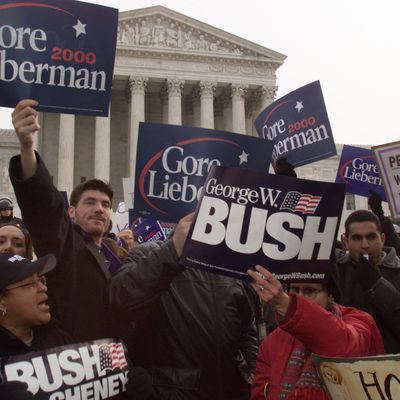
The general topic of wildly partisan Supreme Court rulings is on everybody’s mind right now for some reason. The Washington Examiner’s Tim Carney wants everybody to know that the Supreme Court really, truly did not hand the presidential election to George W. Bush. “You can disagree with the ruling in Bush v. Gore,” writes Carney, “but you can’t honestly argue that it decided the election.”
Well, yes, you can. In fact we know nearly for certain that the recount stopped by the Supreme Court would have given Gore the lead. (Of course, it’s entirely possible that the Republican-controlled Florida legislature would have simply overridden the results of the count and handed the state to Bush, as it threatened to do.) But Carney is repeating a common misconception.
The myth that Bush would have won had the recount proceeded dates back to a recount conducted by a consortium of newspapers that examined the ballots. The consortium found that “If all the ballots had been reviewed under any of seven single standards, and combined with the results of an examination of overvotes, Mr. Gore would have won, by a very narrow margin.” But the newspapers decided that this was not how the counties would have actually tabulated the votes. By the variable standards they would have used, the papers reported, Bush would have prevailed. Thus the national news reported a slew of headlines asserting that Bush would have prevailed.
The conclusion was erroneous. The newspapers assumed that the counties would only have looked at “undervotes” — ballots that did not register any votes for president — and ignored “overvotes” — ballots that registered more than one vote for president. An overvote would be a ballot in which the machine mistakenly picked up a second vote for president, or in which a voter both marked a box and wrote in the name of the same candidate. A hand recount in which an examiner is judging the “intent of the voter” would turn those ballots that were originally discarded into countable votes.
Counting overvotes in which the intent of the voter was clear would have resulted in Gore winning the recount. And subsequent reporting by the Orlando Sentinel and Michael Isikoff found that the recount, had it proceeded, almost certainly would have examined overvotes. (Most of the links have been lost over time, but you can find references here and here.)
The newspapers’ error has to be understood in the context of the time. After Bush prevailed in the recount, there was massive pressure to retroactively justify the processes that led to his victory, in the general spirit of restoring confidence in the system. In the aftermath of the September 11 attacks, that pressure intensified to the point where it was commonly opined that the newspapers ought to entirely cancel the recount (scheduled to come out in November 2001, at the height of the rally-around-Bush moment). In that atmosphere, the newspapers grasped for an interpretation that would both reassure most Americans of what they wanted to believe and avoid placing themselves in opposition to a powerful and bipartisan rallying around Bush that was then at its apogee.
Now, the actual effect of the recount is obviously something of a side issue when assessing the actions of the Court. Nobody knew the outcome of the recount, only that it threatened to make Al Gore president, and stopping it would guarantee Bush’s victory. That is the environment in which five Republican-appointed justices essentially invented a one-time-only ruling to stop the recount. And that’s the relevant history in which to understand the Court’s decision to make up its own new legal theories about the regulation of the health-care market now.






























